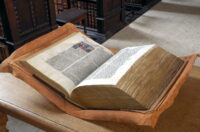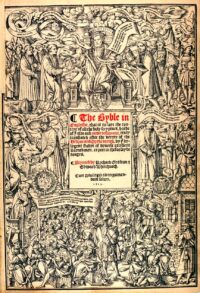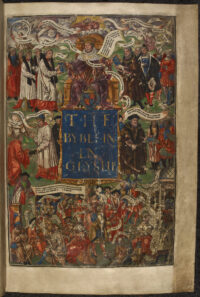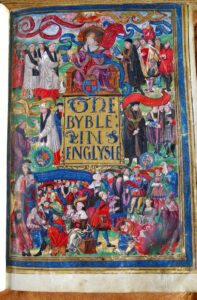 Thomas Cromwell, Henry VIII’s favorite and chief minister until he met a sharp end, played an outsized role in the English Reformation’s violent severing of relations with the Catholic Church. He led the charge on the Dissolution of the Monasteries, ordered destruction of all artwork, church decoration, relics and books he deemed idolatrous/superstitious/popish (Oxford’s entire library was destroyed) and chaired the synod that established Church of England doctrine. The Great Bible of 1539, the first authorized edition of the Bible in English, was commissioned by Cromwell who then ordered its distribution. On September 5th, 1538, the crown, ie, Lord Keeper of the Privy Seal Thomas Cromwell, issued an injunction that every parish in England and Wales buy a copy of the Bible in English and set it up “in sum convenient place” so that all parishioners could read it. The first printed copies of the first national Bible, known as the Great Bible due to its large size, went on sale in April of 1539.
Thomas Cromwell, Henry VIII’s favorite and chief minister until he met a sharp end, played an outsized role in the English Reformation’s violent severing of relations with the Catholic Church. He led the charge on the Dissolution of the Monasteries, ordered destruction of all artwork, church decoration, relics and books he deemed idolatrous/superstitious/popish (Oxford’s entire library was destroyed) and chaired the synod that established Church of England doctrine. The Great Bible of 1539, the first authorized edition of the Bible in English, was commissioned by Cromwell who then ordered its distribution. On September 5th, 1538, the crown, ie, Lord Keeper of the Privy Seal Thomas Cromwell, issued an injunction that every parish in England and Wales buy a copy of the Bible in English and set it up “in sum convenient place” so that all parishioners could read it. The first printed copies of the first national Bible, known as the Great Bible due to its large size, went on sale in April of 1539.
Two presentation copies were printed, one for King Henry VIII and one for Thomas Cromwell. These were luxury editions, with parchment pages instead of paper and the illustrations, black-and-white woodcuts in the standard copies, elaborately hand-painted to look like illuminations. Henry’s copy is in the British Library. The Cromwell copy is now in the Old Library of St John’s College, Cambridge.
 The frontispiece of the Great Bible was not what you would call subtle about its propagandistic purpose. The dominant figure, larger than everyone else and enthroned above the title is Henry. Jesus is crammed uncomfortably into a small cloud-lined gap above him. He doesn’t even have space to raise his head so it sort of flops on his shoulder. Just below to his right is a much smaller Henry VIII, his imperial crown on the ground, kneeling in the presence of God. Banderoles contain biblical passages from Isaiah and Acts of the Apostles that heavy-handedly replace King David with Henry as the man God has chosen to fulfill his will. Kneeling Henry replies in his banderole with a quote from Psalm 118, speaking as David.
The frontispiece of the Great Bible was not what you would call subtle about its propagandistic purpose. The dominant figure, larger than everyone else and enthroned above the title is Henry. Jesus is crammed uncomfortably into a small cloud-lined gap above him. He doesn’t even have space to raise his head so it sort of flops on his shoulder. Just below to his right is a much smaller Henry VIII, his imperial crown on the ground, kneeling in the presence of God. Banderoles contain biblical passages from Isaiah and Acts of the Apostles that heavy-handedly replace King David with Henry as the man God has chosen to fulfill his will. Kneeling Henry replies in his banderole with a quote from Psalm 118, speaking as David.
Archbishops, their mitres on the ground, and courtiers, hats in hand, flank the grand enthroned Henry on both sides as if they were apostles or angels to his Christ. Thomas Cranmer, Archbishop of Canterbury on Henry’s left and Thomas Cromwell on his right receive the Verbum Dei (Word of God) directly from the king. In the second tier, they, now wearing their chapeaux, pass the Bible to (hatless) parish priests and nobility. They (hats on) then deliver it to the grateful masses at the bottom who cheer “Vivat Rex” and “God Save the Kynge.”
The message is clear: Henry is second only to God in spiritual authority and it is he, through his personal gift, who transmits the word of God to his people. The Byzantine hierarchies and Latin texts of Roman Catholicism hold no sway in Henry’s England. His people can read the Word for themselves.
 Cromwell’s high station would soon come crashing down. He backed the wrong horse after the death of Jane Seymour and Henry was disgusted with Cromwell’s choice of Anne of the Cleves for wife #4. He had to go through with the wedding so as not to piss off the Germans, but their marriage was never consummated and was annulled July 9th, 1540. Thomas Cromwell was executed for heresy and treason on July 28th, 1540. His heraldic insignia, originally in a roundel at his feet, were excised from all editions of the Great Bible printed after July 1540.
Cromwell’s high station would soon come crashing down. He backed the wrong horse after the death of Jane Seymour and Henry was disgusted with Cromwell’s choice of Anne of the Cleves for wife #4. He had to go through with the wedding so as not to piss off the Germans, but their marriage was never consummated and was annulled July 9th, 1540. Thomas Cromwell was executed for heresy and treason on July 28th, 1540. His heraldic insignia, originally in a roundel at his feet, were excised from all editions of the Great Bible printed after July 1540.
The frontispiece for Henry’s lavish presentation copy went beyond the mere excision. Both iterations of Cromwell — him receiving the Bible from Henry and then passing it to the lay nobility — were painted over entirely by a grey-haired gent, possibly his successor as Lord Privy Seal John Russell, 1st Earl of Bedford, and the empty roundel that had held Cromwell’s coat of arms filled in with a floral accent.
 Now researchers have discovered that there were alterations made to Cromwell’s copy too. Queen Mary University of London historian Dr. Eyal Poleg and Dr. Paola Ricciardi of Cambridge’s Fitzwilliam Museum turned an x-ray spectrometer a high-powered digital microscope to the title page. They discovered the face of Cromwell distributing the Bible was covered with someone else’s visage painted onto vellum and pasted on top of the original.
Now researchers have discovered that there were alterations made to Cromwell’s copy too. Queen Mary University of London historian Dr. Eyal Poleg and Dr. Paola Ricciardi of Cambridge’s Fitzwilliam Museum turned an x-ray spectrometer a high-powered digital microscope to the title page. They discovered the face of Cromwell distributing the Bible was covered with someone else’s visage painted onto vellum and pasted on top of the original.
Dr Poleg believes the change was made to shore up Cromwell’s position with Henry who still had doubts about the move towards Protestantism. He said: “In the original title page, Cromwell is associating himself with the person distributing Bibles. This was a very dangerous position to be in because Henry was not fully supportive of the new Bible. Cromwell realised this so he tweaked the images to place himself receiving a Bible from Henry. He would have employed an artist to add in a portrait of himself receiving the Bible from Henry.
“It’s been done so professionally that a microscope and a good light source are needed to see it. It’s painted on a separate piece of vellum and then glued on. This makes it the last known portrait of Cromwell before his execution. Cromwell is often seen as a reformer who moved the country very ardently in the direction of Anglicanism and here he is shown as someone who understands politics very well, and actually tries to position himself in the right location. He was very much aware of Henry’s hesitation regarding the Bible and he’s very good at playing the political game. This adds to our growing understanding of Cromwell and the uncertain course of English Reformation.”
Researchers also spotted another change likely intended to curry favor with the king. Cromwell had a miniature portrait of Jane Seymour, the queen who had finally given Henry his male heir and died from it, pasted over one of the commoners, a woman with three children at her feet.
Dr Poleg said: “The page was manipulated to present Henry with an image of Jane Seymour. Cromwell was using Jane to persuade the King of the value of the Bible. When the Bible was produced, Jane had recently died, so she was still Henry’s beloved Queen. And because she had given birth to their son Edward, putting her in a scene with children makes a lot of sense.”
I would have thought that during and after the Dissolution, Thomas Cromwell would have been untouchable. Without Cromwell, it could be said that King Henry would never have achieved his religious and political goals. Yet Cromwell was executed for treason and heresy!
Friends,
This smacks of those Soviet photos where purged members of Stalin’s inner circle magically disappear from the Kremlin reviewing stand in each subsequent issue. And who says you can’t change history? Well, maybe not, but self-serving despots often try.
Yours Aye,
Mungo Napier, Laird of Mallard Lodge 🦆
(aka Garth Groff)
I think Cromwell was done in during a fit of anger that Henry later came to regret.
Cromwell was vulnerable following the disastrous Anne of Cleves marriage and his enemies in that cut-throat court took swift advantage.
This all took place towards the back end of Henry’s reign, but even in the short time left to him, Henry came to regret his loss of Cromwell’s expertise
Wait a minute, Henry has doubts about the move towards Protestantism, Cromwell cuts out his own vellum head (i.e. from distributing Bibles to himself receiving one), while Henry is about to have Cromwells real head cut off completely and Cromwell makes a prayer and he holds a speech on the scaffold, professing to die in the traditional Catholic faith, before his head is then set on a spike and mounted on London Bridge?!?
–Indeed, something must have gone terribly wrong here, and the whole thing might have started with some sort of referendum :no:
Questionably-illiterate leaders are sometimes more concerned with appearance-management than what the Word says…